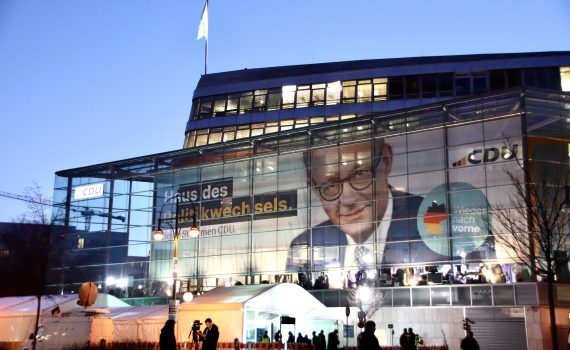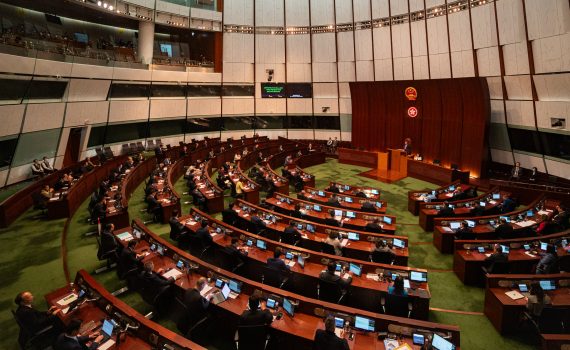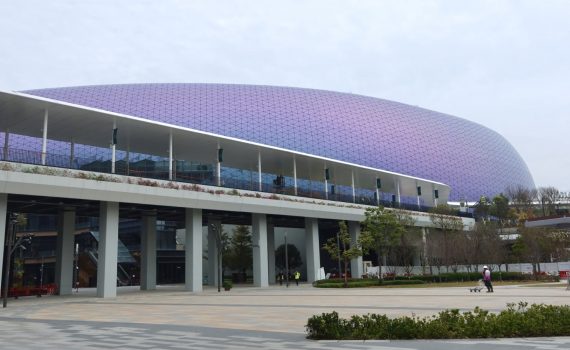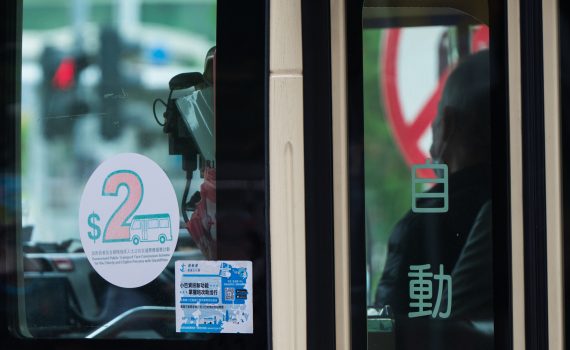Society
Budget 2025 Key Takeaways: Balance public expenditure and maintain Hong Kong’s competitiveness
- 2025-03-03
- Society
- The Young Reporter
- By: AO Wei Ying Vinci、CHAN Wing YiuEdited by: AO Wei Ying Vinci
- 2025-03-03
Hong Kong’s Financial Secretary Paul Chan Mo-po delivered the 2025-2026 Budget speech on Wednesday. He said that “strictly containing public expenditure is a must” and it is crucial to strive for a balance among restoring fiscal balance and lowering potential impacts that may arise. For the coming fiscal year, the total government expenditure will increase by about 8.9% to HK$822.3 billion, while the total government revenue is estimated to be HK$659.4 billion. Chan expects that there will be a deficit of HK$67 billion for the year, and fiscal reserves will decrease to HK$580.3 billion. Here are the key takeaways of this year’s budget plan.
German Election 2025: Tension in central Berlin as election approaches
- 2025-03-01
- Society
- The Young Reporter
- By: Tsz Chiu Ma、LAI Uen LingEdited by: AU YEUNG Jim
- 2025-03-01
Far-right supporters demonstrated against left-wing extremism while antifa supporters called out the rise of fascism in the city centre of Berlin on Feb. 22, one day before Germany’s federal election. One of the right-wing protests was organised by Ferhat Sentürk, the founder and leader of a far-right party, Bürgerliche Allianz Für Deutschland, or Civic Alliance for Germany, formerly a member of Alternative for Germany, or AfD. A group of far-right supporters marched from Dorothea-Schlegel-Platz near Friedrichstraße Station to Berlin Central Station waving the national flag of Germany. Meanwhile, another group of antifa supporters gathered in Schiffbauerdamm to protest against the far-right supporters. Police set up blockades on both sides of the far-right demonstration route to prevent clashes. “If you have a child as a woman, you may not be able to have a legal abortion because some populists and moralists believe that our self-determination does not matter,” said Penelope Alva Frank, a LGBTQ activist, during a speech in the antifa protest. “We have to show that we resist as German people against this far-right propaganda, and this far-right movement is against human rights,” said Marianna, a Green party and antifa supporter who did not disclose her surname because of privacy concerns. Despite police interventions, some antifa supporters managed to block far-right protesters on Hannoversche Strasse for about an hour. The Young Reporter reached out to a number of far-right supporters during their demonstration, but they claimed they do not speak English. The far-right AfD gained widespread support in states that were formerly part of East Germany and nearly doubled their seats to 152 in the Bundestag, according to the Federal Returning Officer. The Christian Democratic Union and Christian Social Union in Bavaria, a centre-right alliance, won 208 seats and became the dominant force in the Bundestag. The incumbent governing coalition, …
German Election 2025: Right-wing parties take over parliament with record high turnout
- 2025-02-27
- Society
- The Young Reporter
- By: LAI Uen Ling、Tsz Chiu MaEdited by: AU YEUNG Jim
- 2025-02-27
Germany shifts to the right after reaching a voter turnout of 82.5% in the 2025 federal election, a record high since the unification of Germany. On Sunday, voters elected a new Bundestag, the lower house of parliament. The Christian Democratic Union of Germany and the Christian Social Union in Bavaria, commonly known as CDU/CSU, a centre-right political alliance, top the election result taking 208 seats with 28.5% of the votes. The far-right nationalist party, Alternative for Germany, or AfD, comes in second with a record 20.8% votes. It now holds 152 seats, according to The Federal Returning Officer. Friedrich Merz, the chancellor candidate of CDU/CSU, is set to become Germany's next leader,and will put together a governing coalition. Prior to the election, CDU/CSU was the largest opposition party in the Bundestag. CDU represented the alliance in 15 of the 16 states, while CSU only contested in the southeastern state of Bavaria. Mark Schneider, CEO of a startup company and a member of CDU, said he believes the party can form a strong government that is able to make clear decisions. “Germany is facing a downshift in the economy. We are not in the best moment,” Schneider said. “Europe has a lot of challenges, including the war in Ukraine. But the last three years of the government were very weak.” He said he would prefer not to have a coalition government, but he suggested the CDU should ally with the Free Democratic Party, another centre-right political party. FDP lost all of its current 92 seats with only 4.33% of the votes, and failed to meet the 5% threshold needed for parliamentary representation. CDU/CSU’s election campaign promised a crackdown on immigration and a deregulation of Germany’s ailing economy. The country’s GDP has decreased for two consecutive years, according to the Federal Statistical …
Budget 2025: Hong Kong Tourism Board to receive funds to boost local art and culture development
- 2025-02-26
- Society
- The Young Reporter
- By: CHAN Hiu Ying、LAU Ka YanEdited by: CHEN Yik Nam、LI Sin Tung
- 2025-02-26
The government will inject HK$1.235 billion into the Hong Kong Tourism Board to promote a series of distinctive tourism products, Financial Secretary Paul Chan Mo-po announced in the budget speech on Wednesday. The Board signed a three-year partnership agreement with international art fair Art Basel to establish immersive experience zones of Hong Kong culture at all four of their shows around the world, strengthening Hong Kong's connection with the global art scene, said Chan. Hundreds of thousands attended Art Basel last year in Europe, the US and Hong Kong. “Art Basel will attract foreign tourists or celebrities, which will bring economic benefit to Hong Kong,” said Kwok Wai-keung, 46, a member of the Legislative Council and Hong Kong Federation of Trade Unions. “I am pretty surprised that the Hong Kong government would put so much support for cultural activities, such as holding Art Basel and developing different types of tourism,” said Carmen Chan, 33, a Canadian tourist. “But I am glad because these activities can help us get to know Hong Kong better, especially to allow my daughter to be exposed to a more diverse culture,” Carmen Chan said. Kwok said that Hong Kong needs to improve technology for tourists. “Hong Kong does not have a special app to facilitate tourists and locals to search for related tourism, such as ‘dianping.com’ [a public review app] from the mainland,” Kwok said. “So Hong Kong needs to work harder to create a platform for visitors to see comprehensive feedback from attractions and restaurants.” “The distinctive tourism projects that the government aims to promote in 2025, including panda, horse-racing and eco‑tourism, must incorporate local cultures that are difficult for other regions to replicate, in order to attract more tourists effectively,” Kwok said. Some have criticised the West Kowloon Cultural District, which is designed …
Budget 2025: Hong Kong increases PhD fellowship quota to attract more outstanding non-local students
- 2025-02-26
- Society
- The Young Reporter
- By: FENG Zhenpeng、Li YinhengEdited by: LIU Yutong
- 2025-02-26
The government said it plans to increase the quota of the Hong Kong PhD Fellowship Scheme and continue its Belt and Road Scholarship to attract more talented international students under the “Study in Hong Kong” brand. The number of places for PhD students will increase from 300 to 400 per year, said Financial Secretary Paul Chan Mo-po in the budget address on Wednesday. The PhD fellowship provides an annual stipend of HK$337,200 and a conference and research-related travel allowance of HK$14,000 per year for a period of up to three years. “The cost of living in Hong Kong is extremely high. International students really need scholarships plus tuition to survive in Hong Kong,” said Felipe Kondo, 21, an undergraduate student from Brazil who received a University Grants Committee scholarship. Hong Kong is the most expensive city in the world for international employees, according to research from HR consulting firm Mercer. “Without the scholarship programs, I do not think I would have come to Hong Kong,” Kondo said. According to official figures, the Hong Kong government set up the Belt and Road Scholarship Scheme in 2016 for students from selected countries, including Indonesia, Malaysia, and Thailand. From 2016 to 2021, more than 330 students from countries along the Belt and Road have received this scholarship from the Hong Kong government, and this number is increasing year by year.
Budget 2025: Budget disappoints elderly and grassroots
- 2025-02-26
- Society
- The Young Reporter
- By: CHENG Tsz Sen Sean、SIU Tsz HangEdited by: Cheuk Chi Maggie YEUNG
- 2025-02-26
The Society for Community Organisation said today that the latest budget proposals are disappointing for Hong Kong’s grassroots and elderly communities. SOCO deputy director Sze Lai-shan said they had hoped for increases in welfare payments to caregivers, elderly people and single non-permanent residents. There is none of this in the budget. For the elderly, Financial Secretary Paul Chan Mo-po proposed to expand the Residential Care Service Voucher Scheme by 1,000 to 6,000 total and the number of vouchers under the Community Care Service Voucher Scheme by 1,000 to 12,000 total. He also promised to boost senior citizens’ buying power by providing an one-off allowance to eligible social security recipients, equal to half of the standard monthly rate for Comprehensive Social Security Assistance payments, Old Age Allowance, Old Age Living Allowance or Disability Allowance. This payment will range from around HK$1,000 to HK$3,600. But Sze said the budget plan is sacrificing the interest of elderly people. “Since elderly people are earning less money, they rely on the government’s support. The government should consider developing the economy without exploiting elderly people’s welfare,” Sze said. Construction worker Lee Cheuk-ming, 61, said the government should not be harsh on elderly people. “The government pointed its knife to the elderly in this budget plan. Freezing civil service workers' salaries is not enough. Cutting parts of their welfare to cover community support is what we want in this budget plan,” Lee said. Lily Kwan, 69, said that elderly people should receive more financial support despite the fiscal deficit. Kwan said that it is better to have the extra allowance than nothing, at least she can have one better meal. “The government should spend more on our living quality and sense of well-being,” she added.
Budget 2025: Paul Chan eyes Kai Tak Sports Park to spur tourism
- 2025-02-26
- Society
- The Young Reporter
- By: ZHOU Yun、TANG SiqiEdited by: WANG Jing
- 2025-02-26
Financial Secretary Paul Chan Mo-po proposed in today’s budget speech that has his eyes on Kai Tak Sports Park to spur the tourism industry. “The Government has been supporting the staging of major international sports events in Hong Kong through "M" Mark System. We will adopt a more strategic approach in continuously attracting sports events which can bring significant economic benefits to Hong Kong, and are in discussion with LIV Golf which has been held in Hong Kong for two consecutive years to explore long-term partnership,” he told the Legislative Council this morning. Following the completion of five tests on the venue, including the ticketing system and crowd management, the park is set to officially open in three days. “The park will provide a world class venue for hosting international mega events, taking forward the development of culture, sports and tourism as an industry in Hong Kong,” said Chan. In 2024, 4.5 million visitors came to Hong Kong, an increase of 32.35% from 2023, according to the government figures. “Modern culture, such as sports events and concerts, are important elements in driving tourism today,” said Ervi Liusman, Senior Lecturer of Hotel and Tourism Management at the Chinese University of Hong Kong. The Kai Tak Sports Park has 50,000 seats, which is about four times more than that of the AsiaWorld-Expo. “Some international singers who want to hold concerts in Hong Kong gave up their bids due to venue size restrictions,” Liusman said. “But Kai Tak Sports Park offers a lot more space.” The park is the only venue in Hong Kong that meets the requirements of multiple international events, which can host sports and cultural activities under any weather conditions. Up till now, the park has contacted over 200 local and overseas sports and non-sports event organisers. About 50 companies …
Budget 2025: Waste-to-energy scheme and electric taxis in Green City plan
- 2025-02-26
- Society
- The Young Reporter
- By: CHEN Yongru、LIN XiaoyouEdited by: Lok Tung LAU
- 2025-02-26
Hong Kong Financial Secretary Paul Chan Mo-po announced this morning a plan to get rid of Hong Kong’s landfills. “I·PARK1”, the first waste-to-energy facility for treating municipal solid waste, will be commissioned this year. A second major facility, “I·PARK2”, is up for tender. Once completed, “I·PARK2” is expected to treat 6,000 tonnes of municipal solid waste per day. This year's Green City proposals also include fare reduction and recycling, green transformation of public transport, and smart green mass transit systems. To enhance waste reduction from the source, Chan said the government will allocate an additional HK$180 million to increase the number of smart food waste recycling bins and food waste collection facilities in residential buildings across Hong Kong, expand the recycling network, and increase the amount of waste collected. According to the Environmental Protection Department, “I·PARK1” advanced incineration technology, combined with mechanical sorting and recycling facilities to recover resources from municipal mixed waste and convert the generated heat into electricity, reducing pollutant emissions “Hong Kong is in urgent need of facilities such as I·PARK1 and I·PARK2 in order to convert waste into energy,” said Tsou Jin-yeu, the Founding Committee Member of the China Green Building (Hong Kong) Council. Leung Yee-tak, Chairman of the Asian Intelligent Building Association, said construction waste is still a problem. “Ash produced after incineration, including bottom ash and fly ash, needs to be properly disposed of.” Leung said. “At present, there is excess capacity of building materials in the mainland, the demand for furnace bottom ash is not high, and the treatment technology of fly ash is not mature.” “Although the facility is capable of generating electricity, the incineration process can still produce pollutants, so it needs to be strictly controlled,” he said. “Another key point to achieving energy saving is the user. The government should …
Budget 2025: HK$2 transport subsidy scheme capped at 240 trips a month
- 2025-02-26
- Society
- The Young Reporter
- By: LEUNG Chi Ngai、YAM Long Hei JamieEdited by: Chun Lim LEUNG
- 2025-02-26
Passengers of public transport over 60 years old will have their HK$2 rides limited to 240 trips per month, Financial Secretary Paul Chan Mo-po proposed in this year’s budget speech. For trips below HK$10, eligible passengers will continue to pay HK$2, but for trips costing more than HK$10, they will have to pay 20% of the total fare. The updated scheme preserves the policy intent while striking a balance on “enhancing the sustainability of the scheme and minimising the impact on the beneficiaries,” said Chan. Government reimbursements to public transport operators is estimated to hit a record high of HK$5.4 billion in 2025-2026, more than tripled compared to HK$1.4 billion in 2021-2022, according to government figures. Currently, the HK$2 subsidy scheme which allows all permanent residents over 60 years old to take public transport for two dollars per trip comprises 0.7% of the total government recurrent expenditure. Dai Fung-wa, 80, who lives in Mei Tin Estate in Tai Wei, said the new policy is unfair to people over 70 years old. Dai said people between 65 and 70 years seldom take public transport after retirement. “You can still work in your 60s, but if you are over 70, you can only take care of your grandchildren at home,” Dai said. Government figures show that 49.4% of residents aged between 60 and 64 years were in the labour force in the past three months, compared to 13.7% of those over 64 years old. Government expenditure on the HK$2 scheme is more than doubled in 2022-2023 from HK$1.4 billion to HK$3 billion, when the eligibility age was lowered from 65 to 60, with extended coverage to include red minibuses, kaito ferries and trams. Lam Chun-sing, Legco member for the Federation of Hong Kong and Kowloon Labour Unions said subsidising transport for …
Themed restaurants offer new experiential consumption culture
- 2025-02-24
- Society
- The Young Reporter
- By: ZHOU Yun、LIN XiaoyouEdited by: CAO Jiawen
- 2025-02-24
At Ramen Iroha, a cartoon dog co-branded theme restaurant in Causeway Bay, Iris Lee, 20, takes pictures of the dishes and shares them on Instagram. “I’m a fan of Pochacoo,” Lee said. “I come here not just because the ramen is delicious but to experience being surrounded by lovely Pochacoo.” All the decorations in Ramen Iroha are filled with Pochacco elements, including the food itself. Soon after its launch in December 2024, an Instagram post on Ramen Iroha went viral, attracting long lines of customers. Cyrus Lin, 37, the founder of Ramen Iroha, said during the peak hours, consumers may have to wait in line for up to three hours. “Today’s consumers attach great importance to the experiential value of their purchases and seek emotional engagement and social interaction with brands,” Lin said. “I love Pochacco, I came specifically to check in after reading the promotion on Instagram,” said Donnie Yu, 27, a bank worker. “I will also share my dining experience on social media.” “In an era dominated by social media, I think sharing unique experiences has become an important consumption trend,” Yu added. “Sharing such experiential consumption experiences satisfies my emotional and social needs.” Ramen Iroha is one of many restaurants that have risen in fame in the city in recent months and co-branded with well-known intellectual property images. Since January, co-branded restaurants such as Kingsley Cafe × Snoopy, Black Wood LZAKAYA × Cinnamoroll, and ABURI EN × Attack on Titan have also been launched. “Along with the growth in the number of such restaurants, there is also a growing demand from consumers for immersive experiences in the catering industry,” Lin said. “Space layout, tableware design, dish placement, and even the service style of employees are all details that need to be improved.” Lin said Ramen Iroha will …










